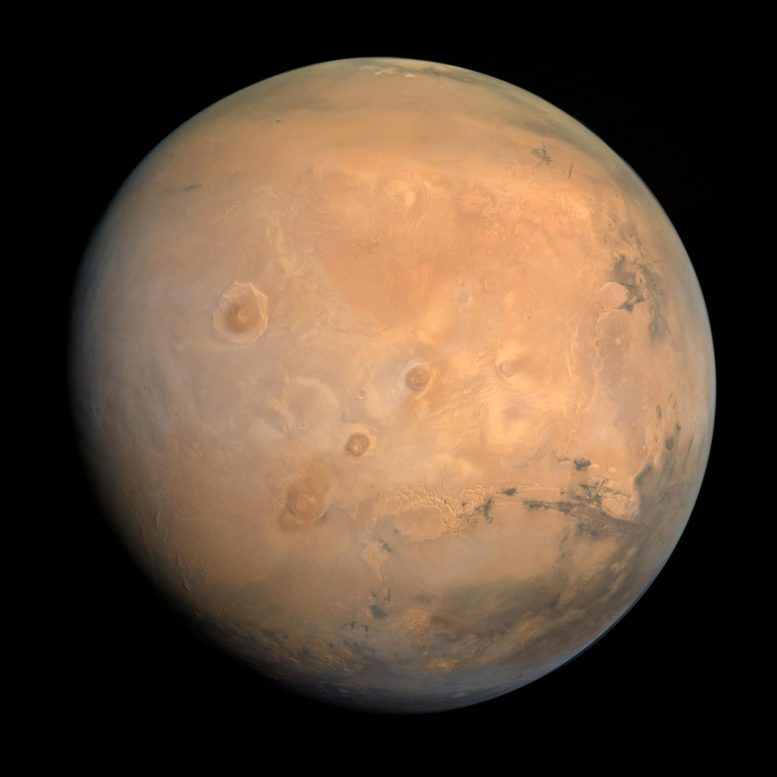
A study reveals that ancient Mars had a significantly low groundwater recharge rate, suggesting that despite evidence of water on its surface, the planet’s water regime was vastly different from Earth’s. This finding, derived from various modeling methods, highlights the challenges in understanding Mars’ hydrological past and has implications for future exploration and the search for water resources. (Artist’s concept.) Credit: SciTechDaily.com
Research indicates ancient Mars had minimal groundwater recharge, vastly differing from Earth’s water dynamics, affecting our understanding of its climate and aiding future Mars missions.
Mars was once a wet world. The geological record of the Red Planet shows evidence for water flowing on the surface – from river deltas to valleys carved by massive flash floods.
But a new study shows that no matter how much rainfall fell on the surface of ancient Mars, very little of it seeped into an aquifer in the planet’s southern highlands.
A graduate student at The University of Texas at Austin made the discovery by modeling groundwater recharge dynamics for the aquifer using a range of methods – from computer models to simple back-of-the-envelope calculations.
Groundwater Recharge on Mars
No matter the degree of complexity, the results converged on the same answer – a minuscule .03 millimeters of groundwater recharge per year on average. That means that wherever rain fell in the model, only an average of .03 millimeters per year could have entered the aquifer and still produced the landforms remaining on the planet today.
For comparison, the annual rate of groundwater recharge for the Trinity and Edwards-Trinity Plateau aquifers that provide water to San Antonio generally ranges from 2.5 to 50 millimeters per year, or about 80 to 1,600 times the Martian aquifer recharge rate calculated by the researchers.
There are a variety of potential reasons for such low groundwater flow rates, said lead author Eric Hiatt, a doctoral student at the Jackson School of Geosciences. When it rained, the water may have mostly washed across the Martian landscape as runoff. Or it may have just not rained very much at all.
Implications for Martian Climate and Exploration
These findings can help scientists constrain the climatic conditions capable of producing rainfall on early Mars. They also suggest a very different water regime on the Red Planet than what exists on Earth today.
“The fact that the groundwater isn’t as big of a process could mean that other things are,” Hiatt said. “It might magnify the importance of runoff, or it could mean that it just didn’t rain as much on Mars. But it’s just fundamentally different from how we think about [water] on Earth.”
The results were published in the journal Icarus. The paper’s co-authors are Mohammad Afzal Shadab, a doctoral student at the Jackson School and faculty members Sean Gulick, Timothy Goudge, and Marc Hesse.

Lead author Eric Hiatt, a doctoral student at the UT Austin Jackson School of Geosciences, with a globe of Mars. Credit: The University of Texas at Austin / Jackson School of Geosciences
The models used in the study work by simulating groundwater flow in a “steady state” environment where inflow and outflow of water into the aquifer is balanced. Scientists then changed the parameters affecting the flow – for example, where rain falls or the average porosity of the rock – and observed what other variables would have to change to maintain the steady state and how plausible those charges are.
While other researchers have simulated groundwater flow on Mars using similar techniques, this model is the first to incorporate the influence of the oceans that existed on the surface of Mars more than three billion years ago in the Hellas, Argyre, and Borealis basins.
The study also incorporates modern topographical data collected by satellites. The modern landscape, Hiatt said, still preserves one of the planet’s oldest and most influential topographical features – an extreme difference in elevation between the northern hemisphere – the lowlands – and the southern hemisphere – the highlands – known as the “great dichotomy.” The dichotomy preserves signs of past groundwater upwelling in which groundwater rose up from the aquifer to the surface. The researchers used geological markers of these past upwelling events to evaluate different model outputs.
Across different models, the researchers found the mean groundwater recharge rate of .03 millimeters per year to match most closely with what’s known about the geologic record.
The research isn’t just about understanding the Red Planet’s past. It has implications for future Mars exploration too. Understanding groundwater flow can help inform where to find water today, Hiatt said. Whether you’re looking for signs of ancient life, trying to sustain human explorers, or making rocket fuel to get back home to Earth, it’s essential to know where the water would most likely be.
Reference: “Limited recharge of the southern highlands aquifer on early Mars” by Eric Hiatt, Mohammad Afzal Shadab, Sean P.S. Gulick, Timothy A. Goudge and Marc A. Hesse, 9 September 2023, Icarus.
DOI: 10.1016/j.icarus.2023.115774
The research was funded by NASA, the University of Texas Institute for Geophysics, and the UT Center for Planetary Habitability.










Deities, whatever names given them by human beings, Allah, Jehovah, God, Yaweh or Ganesh the elephant-headed deity of the Hindus, serve one purpose only. For said humans to have the justification to do what they want, when they want, to whom they want. Any other explanation is anti-science gibberish.
Exactly. One of my favorite quotes (don’t remember from whom) is that, “the Bible was written by man, for man, to control man.” God has nothing to do with the bible, or any text from any religion.
Have to agree with Nigel on this one. It’s like believing in Santa Claus or the Easter Bunny, let’s use our brain here folks.
I asked a preacher once, “why doesn’t God live with us and show himself?” His answer, “this isn’t his world.” 🤔🤨 So… Why then would we even regard God as anything? And Christians use a book that has hypocrisy all over it to govern themselves, interpreting it how they want…? What a bunch of hoopla.
Martch 7,2024
Lately I read Hebrew capter 6,verce 7-8…and found it funny:
but a very good school from Buddah is:
only do agree with what you yourself find is truth…even when you disagree with Buddah!!
If they’re gonna rely on models and simulation to do their “science” for them, they are in for a nasty surprise once the first people finally visit Mars. Which is never, anyway.
Models are the definition of science. The act of performing science is to create a model that provides accurate predictions for the universe we live in. If the models of mars’ climate and geology have nothing to do with reality, then we have a lot to learn about our own planet and how we affect and interact with it. All of science is connected in this way, you can’t just say that X or Y is wrong, as that aff vys anything based on X or Y.
Why would we ever want to land and build a colony on Mars, there is nothing there to sustain life, how many years will it take to get to that stage……